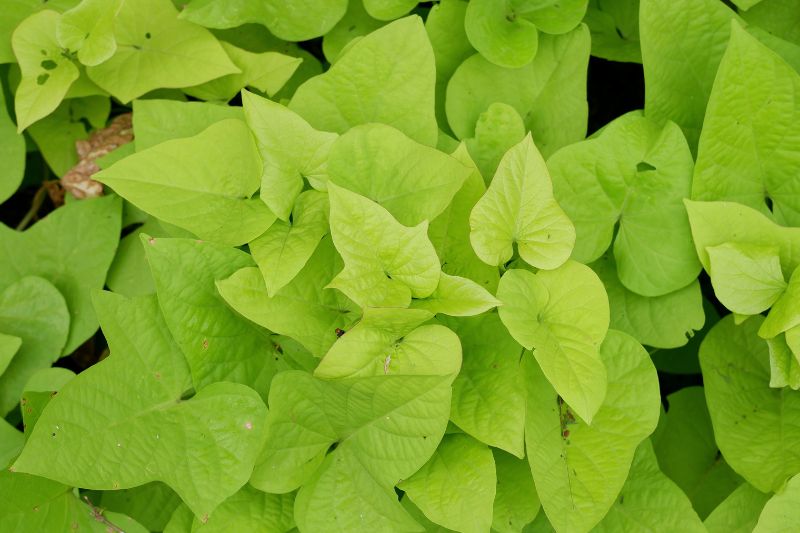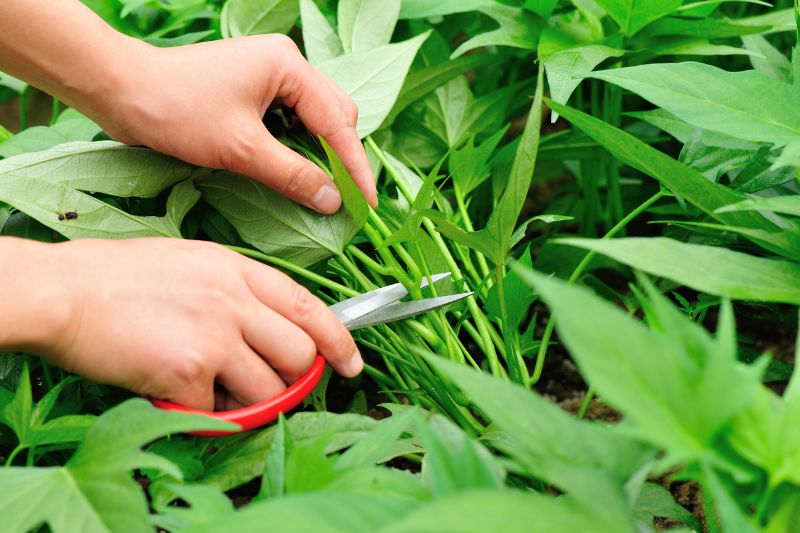Sweet potato – Ipomoea batatas – is cultivated for two main reasons: in the vegetable garden to harvest its tubercles or in the ornamental garden for its attractive cut foliage, sometimes heart-shaped in some varieties, in shades from pale green to purplish violet. But did you know these leaves are also edible? Often underestimated by gardeners, they can be used in the preparation of tasty dishes. Discover how to harvest, prepare and eat sweet potato leaves to make the most of them.
Sweet potato leaves: A nutritious source
Sweet potato leaves are thought to be rich in vitamins A, C and K, as well as iron, calcium and fibre. They are commonly used in African and Asian cuisine, where they are usually sautéed, boiled or added to soups and stews.
Sweet potato varieties and flavour of the leaves
In general, leaves of all sweet potato varieties are edible. However, some varieties are better suited to eating than others, particularly those grown in the vegetable garden:
- 'Bonita' : Known for its tubercles and its green, tender and flavoursome leaves, ideal for stir-fries and salads.
- 'Sakura' : Sakura's dark, almost black leaves are tender and edible, perfect for salads and stir-fries.
- 'Beauregard' : In addition to its sweet tubercles, its heart-shaped green leaves are also tender and edible.
- 'Satsuma-imo' : Its leaves are often eaten in Asia, appreciated for their tenderness and mild flavour.
Varieties grown for ornamental purposes may have tougher, less flavoursome leaves. Although edible, they are less appreciated for taste and texture.

Flavour of sweet potato leaves
Sweet potato leaves have a slightly sweet, earthy taste, with a tender texture when well prepared. They can be compared to spinach or beet leaves, but with a milder flavour. When raw, they have a slight bitterness, which lessens after cooking. Young leaves are more tender and have a milder taste, while more mature leaves can be somewhat tougher and bitter.
Precautions to take
- Ensure young plants have not been treated with pesticidal or other treatments before consuming leaves.
- To avoid digestive upset, start by eating small amounts and increase gradually.
- Allergies: As with any new food, check for allergic reactions by eating a very small amount at first.
Harvesting sweet potato leaves
Harvest of sweet potato leaves can begin as soon as the young plant has produced a good amount of foliage. Generally, leaves can be harvested throughout the growing season (summer to autumn), but they are more tender and flavoursome before the flowering of the young plant.
Cutting method:
- Use clean garden scissors or a sharp knife.
- Cut leaves at base of stem, taking care not to damage main stem.
- Avoid harvesting more than one third of leaves at a time so as not to weaken the young plant.
Precautions:
- Ensure cutting tools are clean to avoid spreading disease.
- Harvest leaves in the morning, when young plants are still hydrated, for best quality.

Cleaning sweet potato leaves
Wash sweet potato leaves as you would wash salad leaves: soak them in a large bowl of cold water to loosen dirt and insects, then rinse under running water. Dry them with a clean tea towel or a salad spinner to remove excess water.
Storage
As with lettuce, sweet potato leaves should be eaten quickly. They also keep in an airtight container for 3 to 5 days in the fridge.
Recipes and ideas for using sweet potato leaves
In salad
Sweet potato leaves can be added raw to salads to bring a green, nutritious touch. They are usually sliced.
Sweet potato leaf and tomato salad: Mix sliced sweet potato leaves with cherry tomatoes, cucumber, red onion and a light dressing of olive oil and lemon.
Garlic-sautéed sweet potato leaves:
Heat 2 tablespoons olive oil in a frying pan. Add 2 crushed garlic cloves, then 2 cups chopped or sliced sweet potato leaves. Sauté for a few minutes until tender. Season with salt and pepper.
Soups and broths
Add chopped sweet potato leaves to homemade vegetable soup a few minutes before the end of cooking. They go well with carrots, celery, courgettes, peppers and potatoes.
Green smoothie with sweet potato leaves
Blend 1 cup sweet potato leaves with 1 banana, 1 cup spinach, 1 cup almond milk and 1 tablespoon honey. This smoothie is perfect for a nutritious breakfast.
Sweet potato leaf pesto
Blend 2 cups sweet potato leaves with 2 garlic cloves, 1/2 cup walnuts, 1/2 cup grated Parmesan and 1/2 cup olive oil until smooth. Use this pesto on pasta or sandwiches.
Sweet potato leaf curry
Sauté 1 sliced onion and 2 chopped garlic cloves in 2 tablespoons oil. Add 1 teaspoon curry powder, 1/2 teaspoon cumin and 1/2 teaspoon turmeric. Stir in 2 cups chopped sweet potato leaves, 2 sliced carrots and 1 cup peas. Pour in 400 ml coconut milk and simmer 15–20 minutes until vegetables are tender. Serve with rice.
Tip:
To soften texture and preserve colour, blanch the leaves by plunging them into boiling water for 1 to 2 minutes, then into ice water. Add salt to the boiling water to help preserve colour.
































Comments